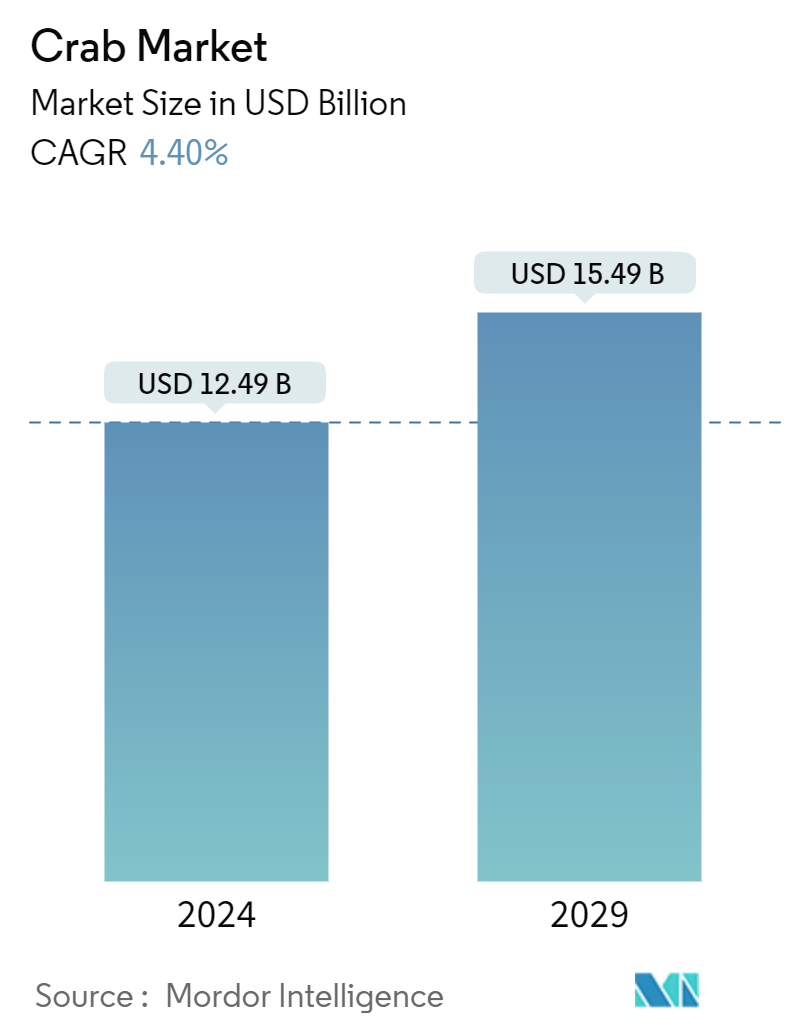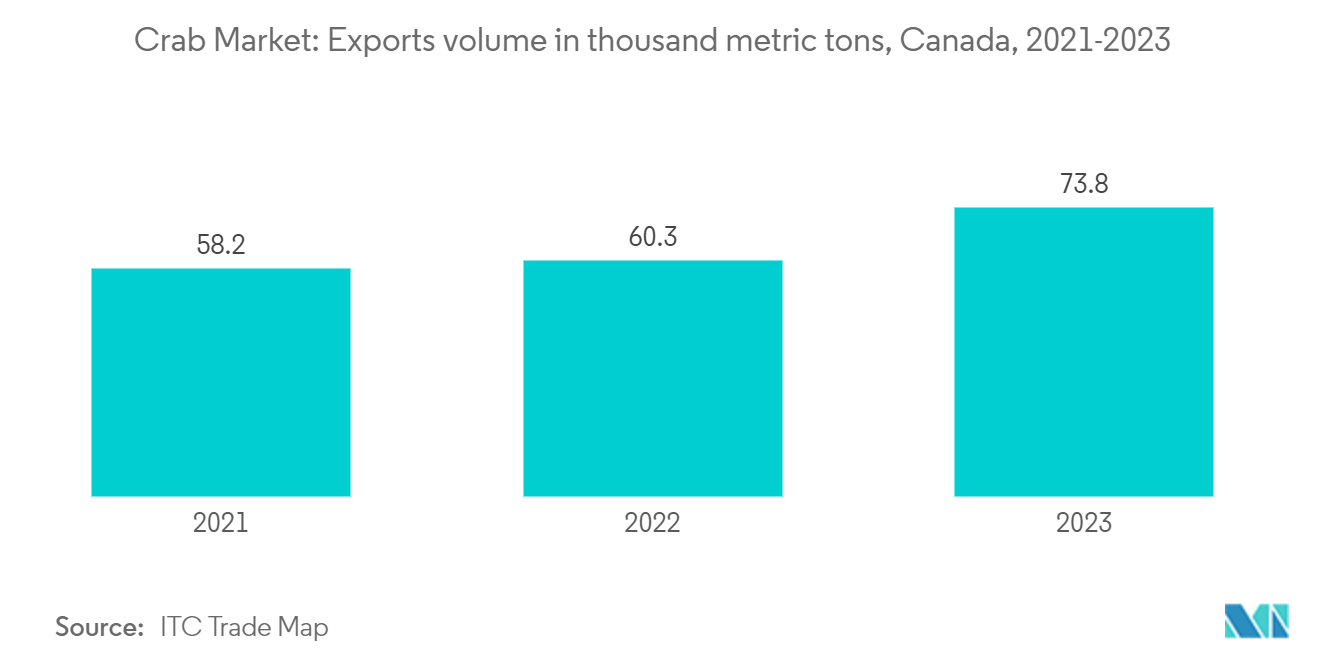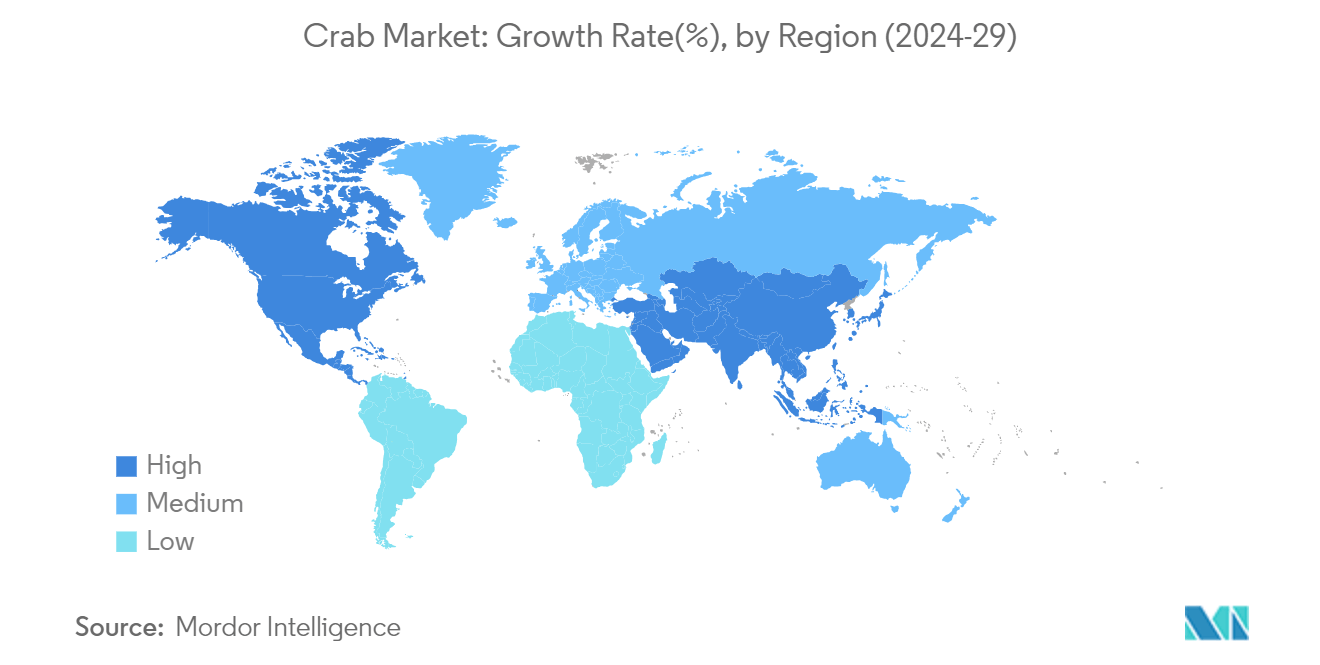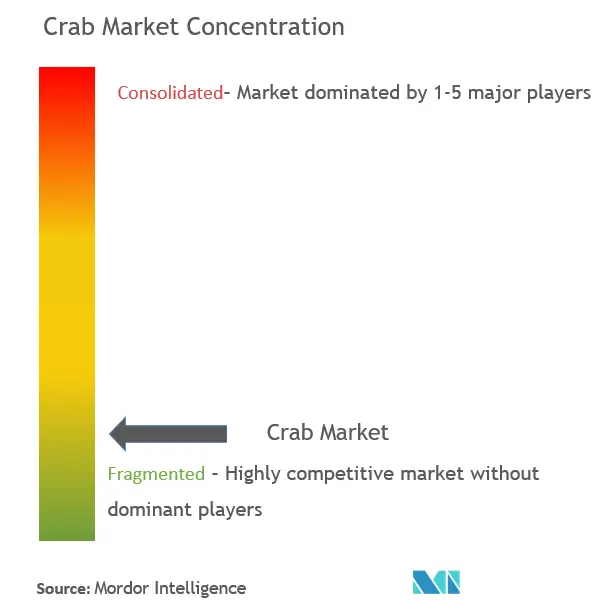Crab Market Size

| Study Period | 2019 - 2029 |
| Market Size (2024) | USD 12.49 Billion |
| Market Size (2029) | USD 15.49 Billion |
| CAGR (2024 - 2029) | 4.40 % |
| Fastest Growing Market | North America |
| Largest Market | Asia-Pacific |
Major Players
*Disclaimer: Major Players sorted in no particular order |
Crab Market Analysis
The Crab Market size is estimated at USD 12.49 billion in 2024, and is expected to reach USD 15.49 billion by 2029, growing at a CAGR of 4.40% during the forecast period (2024-2029).
Crabs come under crustaceans in seafood segments and are one of the major seafood consumed globally. Crabs such as red king crab, blue king crab, opilio, and tanner contain significant protein, vitamin, and mineral content. Crab meat has anti-inflammatory properties that reduce blood pressure and enhance bone and mental health. Such factors and the growing awareness about the health benefits of crab meat are expected to encourage its consumption in the coming years.
Furthermore, the food service industry is the major end-user of crabs. The rise of the food service industry directly affects the global crab market. The food service industry worldwide is multiplying because of new technology, innovations, and customizations in menus. In addition, the inclination toward healthy and nutritious foods and increasing demand for gluten-free diets are expected to support the market’s growth.
Moreover, the demand for frozen crabs is rising in households as they are available year-round, irrespective of the season. They can be used to prepare snacks like crab cakes, crab bisque, crab salad, and crab-stuffed mushrooms at home with minimum cooking. For instance, in 2023, South Korea imported 33.7 thousand metric tons of frozen crab, which was 26.7% more compared to 26.6 thousand metric tons in 2022.
Crab Market Trends
Frozen Crab is Gaining Traction
Frozen crab is typically obtained from freshly caught crabs, which are cleaned, cooked, and then frozen to maintain quality. Freezing helps extend the shelf life of crab meat, allowing consumers to enjoy it beyond the crabbing season. The major countries that produce and export frozen crabs are Canada and Russia. In 2023, Canada exported 73.8 thousand metric tons, which was 22.4% more than the previous year, reflecting the demand for frozen crabs in Canada.
Russia annually produces around 100,000 metric tons of crab, a lucrative segment within its fisheries industry. Traditionally, these exports were predominantly bound for Western markets, notably the European Union and the United States. However, following Russia's invasion of Ukraine in February 2022 and the ensuing trade sanctions, the flow of Russian crabs has notably pivoted toward Asia-Pacific. This geopolitical shift has not only altered crab trade routes but has also significantly impacted supply and demand dynamics. For instance, Japan's frozen crab imports from Russia surged by 18% in 2023, reaching 13,079 metric tons, as reported by the Ministry of Finance, reflecting the growing demand for frozen crab consumption. This uptick in imports can be attributed to declining prices of Russian frozen crab.

North America in the Fastest Growing Region
North America is the fastest-growing region in the crab market; it is one of the major contributors to the total share of the crab market globally. According to a report by the National Oceanic and Atmospheric Administration (NOAA), an increase in seafood landings and rising demand for imported crabs and other seafood from health-conscious consumers have raised the share of seafood in American diets in recent years. Previously, the United States relied on Russian crab imports to meet its demand. However, due to sanctions imposed from May 2023 by the US government, Russian imports were restricted. As a result, other countries now have an opportunity to supply crabs to the US market.
According to the Bureau of Labour Statistics, the average expenditure on fish and seafood per consumer unit in the United States in 2021 accounted for USD 729. Similarly, according to Progressive Grocer, the share of seafood shoppers looking for sustainable seafood products in the United States increased from 2019 to 2021. In 2019, only 29% of seafood shoppers sought sustainable seafood. This figure was at 41% in 2021. Further, Canada is the world’s largest producer of Snow crab, providing about two-thirds of the global supply. With its sweet, flavorful meat, snow crab is one of the most popular crustaceans from the Atlantic. The delectable, snow-white meat is so flavorful that many people enjoy it sans-dipping butter. Snow crab is also popular with home and professional chefs because of its flavorful meat and low cost. As per Fisheries and Ocean Canada, the overall quota of snow crab in division 3K increased by 18% in 2023 to 11,591 metric tons from 9,840 metric tons in 2022. This increase in seafood consumption is expected to boost the growth of the crab market during the forecast period.

Crab Industry Overview
The crab market is highly fragmented, with international and regional companies intensifying the competition for a higher market share and an extended consumer outreach. Some major companies that have indulged in the supply and trade of frozen and canned crabs include Supreme Crab & Seafood Inc., Maine Lobster Now, Pacific Sea Food, Handy Sea Food Incorporated, and Phil-Union Frozen Foods Inc.
Major players in the market have extended their product portfolio and broadened their business to maintain their position in the market. Broadening the product portfolio by introducing various combinations of crab recipes into the market is the strategy these companies have adopted the most.
Crab Market Leaders
-
Supreme Crab and Seafood, Inc.
-
Maine Lobster Now
-
Pacific Seafood
-
Handy Sea Food Incorporated
-
Phil-Union Frozen Foods Inc.
*Disclaimer: Major Players sorted in no particular order

Crab Market News
- September 2023: Handy Seafood launched OLD BAY Crab Cake Minis, offering authentic Maryland crab cake flavor in a convenient microwavable format. These mini crab cakes deliver a delicious taste, combining traditional recipes with modern convenience.
- January 2022: Handy Seafood partnered with Old Bay seasoning and launched seafood products, mainly focusing on crab cakes featuring wild-caught blue swimming crab from fresh crabs.
Crab Market Report - Table of Contents
1. INTRODUCTION
- 1.1 Study Assumption and Market Definition
- 1.2 Scope of the Study
2. RESEARCH METHODOLOGY
3. EXECUTIVE SUMMARY
4. MARKET DYNAMICS
- 4.1 Market Overview
-
4.2 Market Drivers
- 4.2.1 Rising Awareness About the Nutritional Benefits of Crabs
- 4.2.2 Growing Exports with the Rise in Seafood Consumption
- 4.2.3 Rising Initiatives by Government
-
4.3 Market Restraints
- 4.3.1 Growing Inclination of Consumers Toward Plant-based Meat
- 4.3.2 Climate Change Impeding the Growth of Crab Production
-
4.4 Porter's Five Forces Analysis
- 4.4.1 Threat of New Entrants
- 4.4.2 Bargaining Power of Buyers
- 4.4.3 Bargaining Power of Suppliers
- 4.4.4 Threat of Substitute Products
- 4.4.5 Intensity of Competitive Rivalry
5. MARKET SEGMENTATION
-
5.1 By Type
- 5.1.1 Blue Crab
- 5.1.2 Chinese Mitten
- 5.1.3 Gazami Crab
- 5.1.4 Other Crab Types
-
5.2 By Form
- 5.2.1 Frozen
- 5.2.2 Canned
- 5.2.3 Other Forms
-
5.3 By Geography
- 5.3.1 North America
- 5.3.1.1 United States
- 5.3.1.2 Canada
- 5.3.1.3 Mexico
- 5.3.1.4 Rest of North America
- 5.3.2 Europe
- 5.3.2.1 France
- 5.3.2.2 Belgium
- 5.3.2.3 Germany
- 5.3.2.4 Netherlands
- 5.3.2.5 United Kingdom
- 5.3.2.6 Rest of Europe
- 5.3.3 Asia-Pacific
- 5.3.3.1 China
- 5.3.3.2 Indonesia
- 5.3.3.3 Philippines
- 5.3.3.4 Vietnam
- 5.3.3.5 India
- 5.3.3.6 Japan
- 5.3.3.7 Australia
- 5.3.3.8 Rest of Asia-Pacific
- 5.3.4 South America
- 5.3.4.1 Argentina
- 5.3.4.2 Brazil
- 5.3.4.3 Rest of South America
- 5.3.5 Middle East and Africa
- 5.3.5.1 South Africa
- 5.3.5.2 United Arab Emirates
- 5.3.5.3 Rest of Middle East and Africa
6. COMPETITIVE LANDSCAPE
- 6.1 Most Adopted Strategies
- 6.2 Market Share Analysis
-
6.3 Company Profiles
- 6.3.1 Supreme Crab & Seafood Inc.
- 6.3.2 Maine Lobster Now
- 6.3.3 Pacific Seafood
- 6.3.4 Handy Sea Food Incorporated
- 6.3.5 Phil-Union Frozen Foods Inc.
- 6.3.6 JM Clayton Seafood Company
- 6.3.7 RGE Agridev Corporation
- 6.3.8 Siam Canadian Group Limited
- 6.3.9 Handy Seafood
- *List Not Exhaustive
7. MARKET OPPORTUNITIES AND FUTURE TRENDS
** Subject To AvailablityCrab Industry Segmentation
A crab is a decapod crustacean with a hard shell; the meat of a crab is eaten as food.
The crab market is segmented into type (blue crab, Chinese mitten crab, gazami crab, and other types) and form (frozen, canned, and other forms). The market is also segmented by geography, covering more than 16 countries worldwide. The report offers market estimation and forecast in value (USD) and volume (metric tons).
| By Type | Blue Crab | |
| Chinese Mitten | ||
| Gazami Crab | ||
| Other Crab Types | ||
| By Form | Frozen | |
| Canned | ||
| Other Forms | ||
| By Geography | North America | United States |
| Canada | ||
| Mexico | ||
| Rest of North America | ||
| By Geography | Europe | France |
| Belgium | ||
| Germany | ||
| Netherlands | ||
| United Kingdom | ||
| Rest of Europe | ||
| By Geography | Asia-Pacific | China |
| Indonesia | ||
| Philippines | ||
| Vietnam | ||
| India | ||
| Japan | ||
| Australia | ||
| Rest of Asia-Pacific | ||
| By Geography | South America | Argentina |
| Brazil | ||
| Rest of South America | ||
| By Geography | Middle East and Africa | South Africa |
| United Arab Emirates | ||
| Rest of Middle East and Africa |
Crab Market Research FAQs
How big is the Crab Market?
The Crab Market size is expected to reach USD 12.49 billion in 2024 and grow at a CAGR of 4.40% to reach USD 15.49 billion by 2029.
What is the current Crab Market size?
In 2024, the Crab Market size is expected to reach USD 12.49 billion.
Who are the key players in Crab Market?
Supreme Crab and Seafood, Inc., Maine Lobster Now, Pacific Seafood, Handy Sea Food Incorporated and Phil-Union Frozen Foods Inc. are the major companies operating in the Crab Market.
Which is the fastest growing region in Crab Market?
North America is estimated to grow at the highest CAGR over the forecast period (2024-2029).
Which region has the biggest share in Crab Market?
In 2024, the Asia-Pacific accounts for the largest market share in Crab Market.
What years does this Crab Market cover, and what was the market size in 2023?
In 2023, the Crab Market size was estimated at USD 11.94 billion. The report covers the Crab Market historical market size for years: 2019, 2020, 2021, 2022 and 2023. The report also forecasts the Crab Market size for years: 2024, 2025, 2026, 2027, 2028 and 2029.
What are the growing trends in crab consumption?
The growing trends in crab consumption are a) Convenience options b) Pre-packaged crab
What are the growing trends in crab consumption?
The growing trends in crab consumption are a) Convenience options b) Pre-packaged crab
Crab Industry Report
The global crab market is poised for considerable growth, fueled by increasing consumer recognition of crab meat's health benefits and nutritional value. North America, Asia-Pacific, and Europe are pivotal to this expansion, with Asia-Pacific notably thriving due to its growing economies and heightened seafood consumption. Market segmentation by crab types like blue crab, Chinese mitten, and gazami crab addresses diverse culinary preferences and regional tastes. Major market trends highlight an uptick in demand for sustainably sourced and nutritious seafood, promoting the expansion of land-based aquaculture and advances in seafood processing and packaging. The desire for frozen, canned, and fresh crab forms is driven by evolving consumer lifestyles that demand convenience while preserving quality. The competitive landscape is marked by strategic efforts to expand domestic markets and tap into international seafood demand, underscored by technological innovations and sustainable fishing practices necessary for balancing market demand with environmental stewardship. For an in-depth analysis of market dynamics and a forecast outlook, get a deeper insight into this with a sample industry analysis available for free download.



